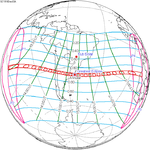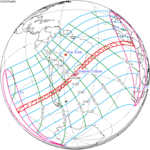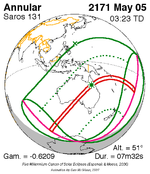This eclipse is a part of Saros series 131, repeating every 18 years, 11 days, and containing 70 events. The series started with a partial solar eclipse on August 1, 1125. It contains total eclipses from March 27, 1522 through May 30, 1612; hybrid eclipses from June 10, 1630 through July 24, 1702; and annular eclipses from August 4, 1720 through June 18, 2243. The series ends at member 70 as a partial eclipse on September 2, 2369. Its eclipses are tabulated in three columns; every third eclipse in the same column is one exeligmos apart, so they all cast shadows over approximately the same parts of the Earth.
The longest duration of totality was produced by member 28 at 58 seconds on May 30, 1612, and the longest duration of annularity was produced by member 50 at 7 minutes, 54 seconds on January 26, 2009. All eclipses in this series occur at the Moon’s ascending node of orbit.[1]
| Series members 39–60 occur between 1801 and 2200: | ||
|---|---|---|
| 39 | 40 | 41 |
 September 28, 1810 |
 October 9, 1828 |
 October 20, 1846 |
| 42 | 43 | 44 |
 October 30, 1864 |
 November 10, 1882 |
 November 22, 1900 |
| 45 | 46 | 47 |
 December 3, 1918 |
 December 13, 1936 |
 December 25, 1954 |
| 48 | 49 | 50 |
 January 4, 1973 |
 January 15, 1991 |
 January 26, 2009 |
| 51 | 52 | 53 |
 February 6, 2027 |
 February 16, 2045 |
 February 28, 2063 |
| 54 | 55 | 56 |
 March 10, 2081 |
 March 21, 2099 |
 April 2, 2117 |
| 57 | 58 | 59 |
 April 13, 2135 |
 April 23, 2153 |
 May 5, 2171 |
| 60 | ||
 May 15, 2189 | ||
References
- ^ "NASA - Catalog of Solar Eclipses of Saros 131". eclipse.gsfc.nasa.gov.